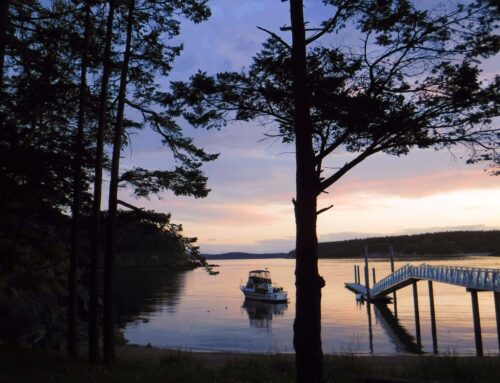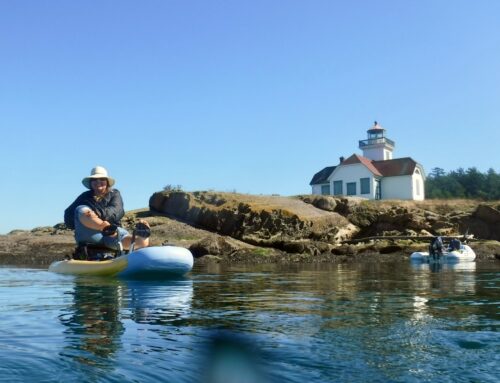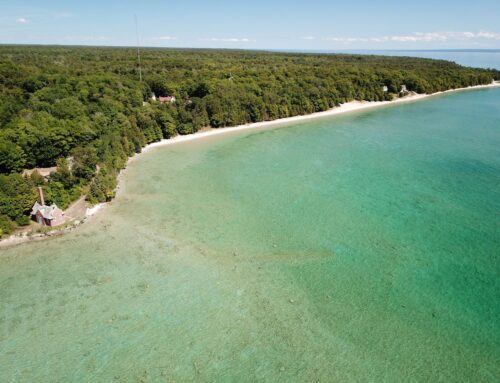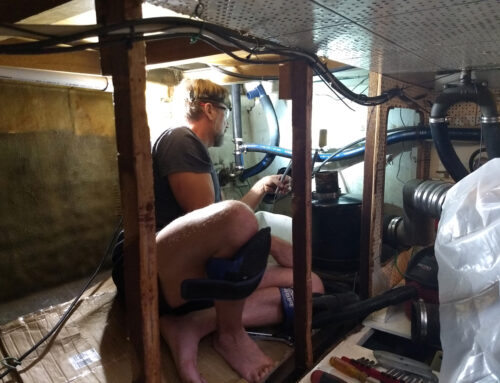If you read the
earlier blog about our adventures in the San Juan Islands you know that we had some problems with our aging gas tanks. They are located in the cockpit in open compartments on both sides of the steering station. Due to their size and shape they are partially exposed to the environment causing the plastic to break down quite rapidly.We replaced one tank by necessity during our trip to the San Juan’s last summer and have since bought another to replace the second tank as well.
 |
| One of the aging tanks in the open compartment. Note the damaged corners. |
 |
| You can see the red tanks on both sides of the steering station |
One of our winter projects was to build enclosures which would protect the tanks as well as look nice. We purchased some
marine-grade polymer![]()
sheets to fabricate the enclosure and cover. The polymer is as easy to work with as wood and should not warp or get discolored. To cover the edges we purchased
angled aluminum![]()
and of course we used lots of stainless steel nuts, bolts, and screws. The tank is vented via a hose leading to the
vent![]()
you can see in the top left in the photo below.
 |
| New port-side gas tank cover simply slides up and out to remove |
Do you need more info about this modification? Leave us a comment with questions and we’ll add the answers to this blog.


![]() sheets to fabricate the enclosure and cover. The polymer is as easy to work with as wood and should not warp or get discolored. To cover the edges we purchased angled aluminum
sheets to fabricate the enclosure and cover. The polymer is as easy to work with as wood and should not warp or get discolored. To cover the edges we purchased angled aluminum![]() and of course we used lots of stainless steel nuts, bolts, and screws. The tank is vented via a hose leading to the vent
and of course we used lots of stainless steel nuts, bolts, and screws. The tank is vented via a hose leading to the vent![]() you can see in the top left in the photo below.
you can see in the top left in the photo below.






Mel Mac 26X 1999 Sioux Lookout, Ontario
First off thank you for the site and the information. We are in the process of ordering our Natures Head from the manufacturer. A few questions regarding the head and your installation.
1. I notice in the picture what appears to be a cut out of the threshold of the head doorway. was this to accommodate the crank handle? was it also because there was insufficient room against the hull? We are ordering the updated “spider handle” do you think this will provide the room needed without the cut out of the fibre glass threshold? Does the cranking system allow manipulating the waste back and forth or just in one direction? Is back and forth necessary do you think.
2. You note that you would not install the solar vent fan, that the supplied fan was sufficient. Is the solar vent (NICRO?) pictured the unit supplied by NatHead? Did they supply a connective system from the vent hose to the solar vent or did you have to make that up yourselves? Without the solar vent would the opening in the window or cabin side be the diameter of the hose? (1 1/2 inches?)
3. We are ordering an additional urine bottle. Do they come with a stopper for when they are not in use? If not how do you cap them until the content can be disposed of in a legal and aesthetically acceptable manner? If I follow you comments correctly, two bottles would allow you from 4 to eight days between emptying. Is that about right?
4. The Nat Head come with a couple of L-brackets to hold it down to the sole (floor). Are they sufficient to hold the head in place while in use in heavy weather? ( an event to be voided I agree, but not always possible)? Is there access to bolt these down or did you use self tapping screws? Is the floor robust enough to carry the weight of the head and passenger without reinforcement? Do you plan on building a platform/floor for the head and would that include stronger fasteners? Does the head design allow for alternate fastener connections?
5. Do you know if Drain Care is available in Canada? Are there alternatives to Drain Care that you are aware of? We have looked at COIR based materials available at Canadian Tire. Is COIR a generic material or does it come in different identities?
Sorry for all the questions and we appreciate your patience with us newbies. Most important THANK YOU for sharing this information and setting up the site.
Fair winds,
Cathy and Mel Wind Dancer Mac 26X 1999 Sioux Lookout, Ontario, Canada
Mel Winddancer Mac 26X 1999. A couple of questions re tanks: Are those 12 gallon tanks? Are the standard fuel lockers big enough or did you cut them out to fit the larger tanks? Did you change the bulkheads forward to accomodate these tanks or did they fit? Have you strapped them down, or down or do you rely on the covers to keep them in place laterally. Where are the fittings and lines leading to the engine. How do you fill your tanks? do they have to be slid out for filling? How do you switch tanks? Do you use a water separator. What is your total fuel capacity? Do you have any idea of the weight of each tank full?
Thanks for this and a great site.
Cheers
Mel
Looks great, and right now I don’t need a new tank, first I need a boat. Michael
Wow! What a smart idea, Captain Mike!